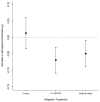Benefit of shading by nurse plant does not change along a stress gradient in a coastal dune
- PMID: 25127399
- PMCID: PMC4134255
- DOI: 10.1371/journal.pone.0105082
Benefit of shading by nurse plant does not change along a stress gradient in a coastal dune
Abstract
The proximity of adult neighbors often increases the performance of woody seedlings under harsh environmental conditions but this nurse plant effect becomes less intense when abiotic stress is alleviated, as predicted by the stress gradient hypothesis (SGH). Although some studies have tested how the net nurse effect is changed by stress, few studies have tested how the mechanism that drives the facilitative effect of nurse responds to changes in stress. We conducted field experiments in a subtropical coastal dune to test if shading drives the known nurse effect of adults of the tree Guapira opposita on seedling performance of another tree species, Ternstroemia brasiliensis. We transplanted T. brasiliensis seedlings to three neighbor environments: under a G. opposita crown, under artificial shade and without neighbor as a control. Furthermore, assuming that proximity to the seashore correlates with stress intensity, we tested if the potential shade-driven facilitation became less intense as stress decreased. Regardless of the proximity to the seashore, after a year, the survival of T. brasiliensis seedlings was twice as high when the seedlings were under G. opposita or under artificial shade compared to the control, indicating that the nurse effect is driven by shade and that this facilitation mechanism is constant along the stress gradient. However, G. opposita and artificial shade had a negative effect on seedlings growth. Overall, our results showed that the facilitation mechanism behind the nurse effect did not wane as the stress was reduced. Furthermore, in spite of the potential costs in terms of biomass production, our study highlights the potential of nurse plants and artificial shade as techniques to improve the survival of transplanted seedlings used in the restoration of degraded shrubland coastal dunes.
Conflict of interest statement
Figures




References
-
- Bonanomi G, Incerti G, Mazzoleni S (2011) Assessing occurrence, specificity, and mechanisms of plant facilitation in terrestrial ecosystems. Plant Ecology 212: 1777–1790.
-
- Callaway RM (1995) Positive interactions among plants. The Botanical Review 61: 306–349.
-
- Flores J, Jurado E (2003) Are nurse-protege interactions more common among plants from arid environments? Journal of Vegetation Science 14: 911–916.
-
- Gómez-Aparicio L, Zamora R, Gómez JM, Hodar JA, Castro J, et al. (2004) Applying plant facilitation to forest restoration: a meta-analysis of the use of shrubs as nurse plants. Ecological Applications 14: 1128–1138.
Publication types
MeSH terms
LinkOut - more resources
Full Text Sources
Other Literature Sources

